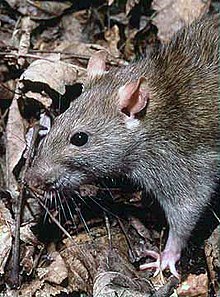Ultrasonic vocalization
John W. Anderson, a professor in the Department of Zoology at Cornell University, was the first to discover that rats were capable of emitting ultrasonic vocalizations.
[8] For example, isolation, aggression between males, appearance of predators, surprising noises and inescapable foot shocks would elicit these vocalizations.
[8] Conversely, the 50-kHz vocalizations emitted by adults are produced during appetitive situations such as social play between juveniles, whilst engaging in mating behaviour, or when the animal is touched gently.
[8] Individual differences, as well as social factors such as housing arrangements, can affect the number of elicited vocalizations and the probability of their occurrence.
[8] Compounds including benzodiazepines, which are positive modulators of GABA receptors, will decrease the production of ultrasonic vocalizations which are emitted in response to social isolation.
[9][10] During emission of 22-kHz calls, juveniles and adults are often exhibiting freezing behaviour and experiencing an increase in heart rate and blood pressure.
[11] As well, brain areas such as the medulla oblongata, the cortex, the amygdala, and the dorsal hippocampus, among others, play a role in 22-kHz calls specifically.
[1] Many of these brain areas/structures have been implicated in studies involving fear and anxiety, and can be associated with a larger network which deals with aversive emotions.
The possible ways in which drugs affect 22-kHz vocalizations has been an area of particular interest, and it has been shown that administering certain benzodiazepines can lead to a reduction in calling behaviour, while certain antidepressants, dopamine reuptake inhibitors, and antipsychotics did not have nearly the same inhibitory effect.
